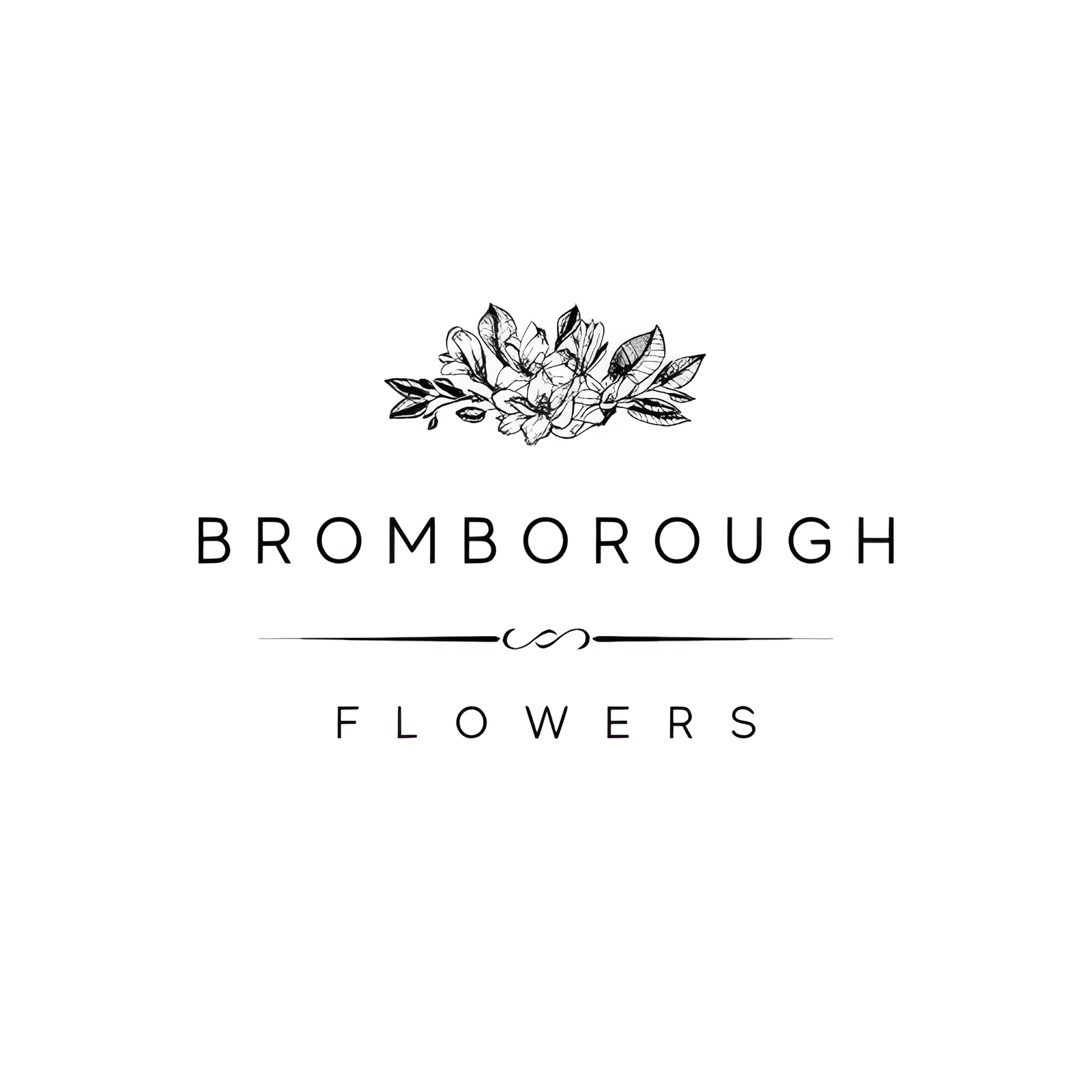In the world of wedding florals, the Gladiolus stands out with its towering presence and diverse palette, offering a refined touch to any ceremony. Known for its impressive height and multiple blooms per stem, this flower not only adds visual drama but also embodies the virtues of strength, sincerity, and generosity. Whether you’re planning an August wedding or seeking a floral arrangement that commands attention, the Gladiolus presents a compelling choice. To fully appreciate its versatility and significance in wedding decor, one must consider its physical attributes, historical origins, and cultural symbolism.
Flower Overview
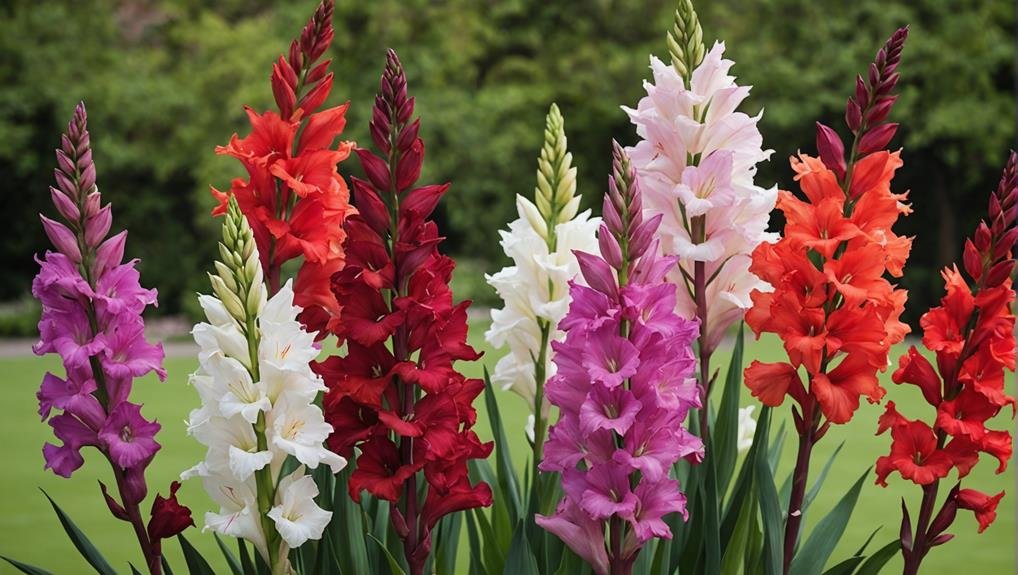
Renowned for their tall, reed-like stems that can reach heights of up to 5 feet, Gladiolus flowers are a striking choice for wedding arrangements. These magnificent blooms come in a diverse array of colors, making them suitable for various wedding themes and palettes. Their vibrant hues symbolize strength, sincerity, and generosity, adding a layer of meaningful symbolism to any celebration.
As wedding flowers, Gladiolus are particularly favored for their long vase life and visually stunning full blooms. This durability ensures that they maintain their beauty throughout the event, from the ceremony to the reception. The flowers’ robust nature and elegant appearance make them a versatile choice for bouquets, centerpieces, and other floral decorations.
In addition to their aesthetic appeal, Gladiolus also carry significant symbolic weight. They are often associated with qualities such as strength of character, moral integrity, remembrance, and admiration. These attributes make them an ideal choice for couples who wish to incorporate deeper meanings into their wedding decor.
Moreover, as the birth flower for August, Gladiolus hold special significance for late summer weddings, adding a personal touch for those celebrating nuptials during this time.
Physical Description
With regards to physical attributes, Gladiolus flowers are characterized by their tall, slender stems that can reach an impressive height of up to 5 feet. These reed-like stems provide a striking vertical element, making Gladiolus flowers an ideal choice for adding height and elegance to wedding floral arrangements.
Each stem is capable of bearing up to 20 large, vibrant flowers, which bloom sequentially from the bottom upwards, creating a cascading effect that is both dramatic and sophisticated.
The structural integrity of Gladiolus flowers is another notable characteristic, as their tall stems are sturdy enough to support the weight of multiple blooms. This durability contributes to their long vase life, making them a practical choice for wedding décor that needs to remain fresh throughout the event.
Additionally, Gladiolus flowers are known for their wide range of hues, which allows them to fit seamlessly into various wedding color schemes and themes.
These attributes, coupled with their symbolic meanings of strength, sincerity, and generosity, make Gladiolus flowers a favored option for weddings. Their towering presence and lush blooms offer a balanced combination of aesthetic appeal and symbolic depth, ideal for commemorating such a significant occasion.
Available Colour Varieties

Gladiolus flowers are available in an extensive palette of colors, including classic shades like white, red, pink, yellow, purple, and orange. This diverse range of color varieties makes gladiolus an exceptionally versatile choice for wedding floral arrangements.
The white color, in particular, is a popular option for weddings due to its association with purity and elegance. White gladiolus can seamlessly fit into a monochromatic color scheme, creating a sophisticated and cohesive look.
Moreover, gladiolus flowers offer more than just solid hues; they also come in bi-colored petals and speckled patterns, adding a layer of visual interest to the arrangements. Some unique color varieties include enchanting shades of blue, green, and lavender, providing endless possibilities for customization based on wedding themes and personal preferences.
The choice of color for gladiolus flowers can greatly impact the overall aesthetic and ambiance of the wedding. Different colors convey varying meanings and symbolism, allowing couples to express their personalities and emotions through their floral selections.
Whether aiming for a vibrant, bold display or a subtle, refined look, the extensive array of gladiolus color varieties ensures that there is a perfect option for every wedding style.
Latin Name and Taxonomy
The genus Gladiolus, belonging to the family Iridaceae, encompasses over 260 species known for their tall spikes of vibrant, sword-shaped flowers. The name Gladiolus is derived from the Latin word ‘gladius,’ meaning sword, which aptly describes the plant’s long, narrow leaves. This genus includes both wild species and numerous cultivated varieties, each contributing to the plant’s esteemed reputation in horticulture and floral design.
Taxonomically, Gladiolus is classified as a cormous flowering plant, characterized by its underground storage organ, the corm, which allows it to survive adverse conditions and flourish annually. The diverse species within this genus exhibit a wide array of colors, sizes, and shapes, making them a versatile choice for various floral arrangements, including wedding bouquets and centerpieces.
The taxonomy of Gladiolus is complex, with ongoing botanical studies continually refining the classification of its species. This genus is notable for its hybrid vigor, resulting in an extensive palette of colors and forms. Despite this complexity, Gladiolus remains a popular and accessible choice for both professional florists and gardening enthusiasts, celebrated for its elegant and striking blooms.
Geographical Origins
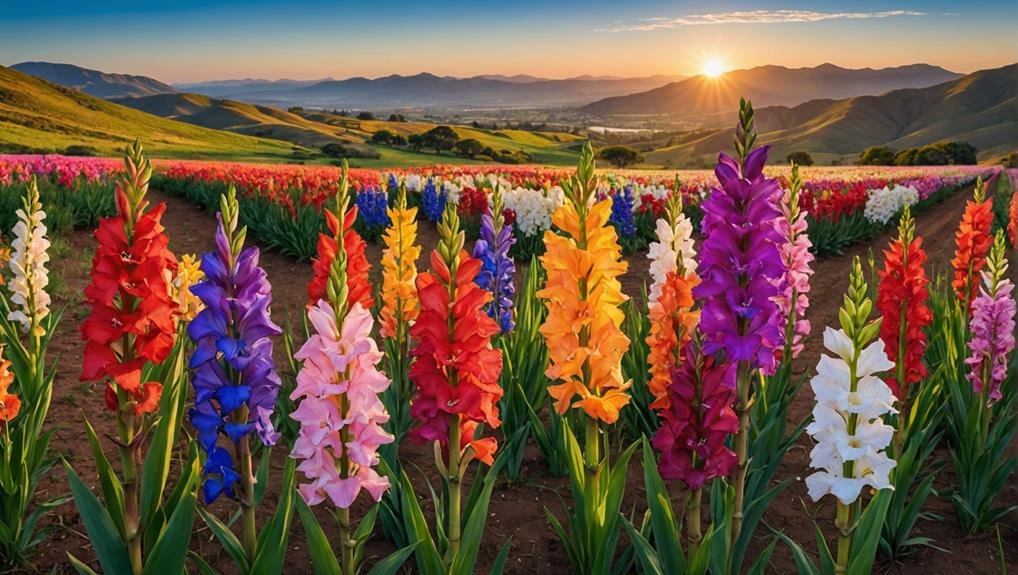
Originating in South Africa, particularly in the Cape of Good Hope region, Gladiolus has a rich geographical history that has greatly influenced its cultivation and popularity. This striking flower, known for its sword-shaped leaves and vibrant blooms, was first introduced to Europe in the late 17th century. The name Gladiolus itself is derived from the Latin word ‘gladius,’ meaning sword, a nod to its distinctive foliage.
| Key Aspect | Detail | Significance |
|---|---|---|
| Origin | South Africa | Native region |
| Specific Location | Cape of Good Hope | Primary cultivation area |
| Introduction to Europe | Late 17th century | Spread of popularity |
| Name Origin | Latin ‘gladius’ (sword) | Describes leaf shape |
The geographical origins of Gladiolus play an essential role in its cultural and horticultural significance. The Romans and Greeks valued these flowers for their beauty and symbolism, further enhancing their desirability. Over time, Gladiolus has become a beloved choice worldwide for weddings and other special occasions, admired for its stunning array of colors and elegant form. Understanding its geographical roots allows us to appreciate how this flower has transcended borders, becoming a symbol of beauty and celebration across different cultures and continents.
Season Availability
Due to their usual bloom period from late spring to early fall, gladioli are most abundantly available during the summer months. This peak availability makes them an ideal choice for summer weddings, where their vibrant and diverse colors can add a stunning visual element to floral arrangements. However, it is important to note that season availability can vary based on location and climate.
Here are some key points to keep in mind regarding the season availability of gladiolus:
- Peak Availability: Gladiolus flowers reach their peak availability during the summer, offering the best selection and quality for wedding decorations.
- Regional Variations: In some regions, particularly those with milder climates, gladioli may be available year-round, although the quality and color intensity might differ.
- Impact on Pricing: Seasonal availability can have a significant impact on the pricing of gladiolus. During peak availability, prices are generally lower, while off-season purchases may be more expensive.
- Color Variations: Spring gladioli often showcase fresh, vibrant colors, perfect for lively spring weddings. In contrast, fall varieties may have deeper, richer hues that suit autumnal themes.
Understanding these aspects of gladiolus season availability helps in planning and budgeting for wedding floral arrangements effectively.
Growing Conditions
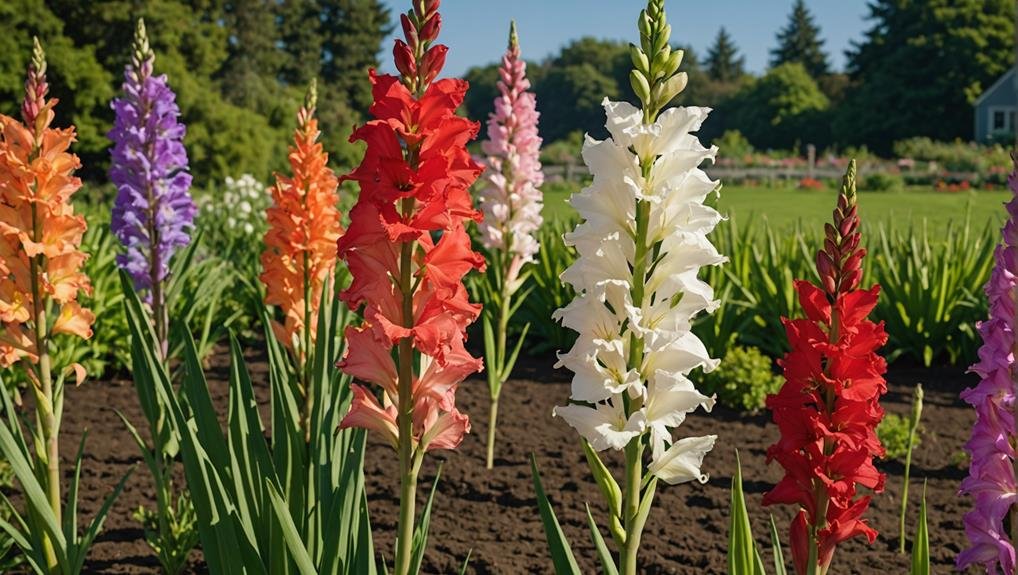
For optimal growth, gladiolus require well-drained soil with a pH range of 6.5 to 7. This guarantees that the plants receive sufficient nutrients, fostering vibrant and healthy flowers, perfect for wedding arrangements.
When planting gladiolus, it is essential to position the corms 3-5 inches deep and space them 4-6 inches apart. This spacing allows the plants to grow without overcrowding, promoting ideal flower development.
Consistent watering is essential for gladiolus, with about 1 inch of water per week being necessary. This regular hydration supports the plants through their growth cycle, guaranteeing they produce the stunning blooms desired in Wholesale Flowers markets.
Gladiolus corms are perennials in USDA zones 8-10, allowing them to thrive and return year after year in these temperate climates.
The size of the corms directly influences the size of the flowers produced. Larger corms typically yield more substantial and more impressive blooms, making them particularly desirable for wedding decorations.
Ensuring these growing conditions are met will result in gladiolus that are not only visually striking but also robust and long-lasting, perfect for creating memorable wedding floral arrangements.
Cultural Significance
Gladiolus flowers hold profound cultural significance, symbolizing strength, integrity, and admiration, which makes them fitting choices for wedding celebrations. These attributes are deeply rooted in historical contexts, enhancing their appeal in ceremonies that emphasize love and commitment. The cultural significance of gladiolus can be appreciated through several lenses:
- Historical Associations: In Roman times, gladiolus were linked to gladiators, embodying the strength of character and courage they required in the arena. This association underscores the flower’s symbolic representation of resilience and determination.
- Birth Flower for August: Gladiolus are the birth flower for August, adding a unique layer of significance for couples choosing to marry in this month. This connection makes them a thoughtful inclusion in wedding arrangements, aligning with personal milestones and astrological traditions.
- Symbolism of Colors: Different colors of gladiolus convey various meanings, allowing for personalized and symbolic expressions in floral arrangements. For instance, red gladiolus signify deep love, while white stands for purity and sincerity.
- Remembrance and Respect: Gladiolus are often used in funeral arrangements, symbolizing remembrance and respect. This duality in their use highlights the flower’s versatility and profound impact on ceremonies marking significant life events.
These cultural touchpoints make gladiolus a meaningful choice for weddings, embodying a rich tapestry of values and traditions.
Typical Use in Weddings
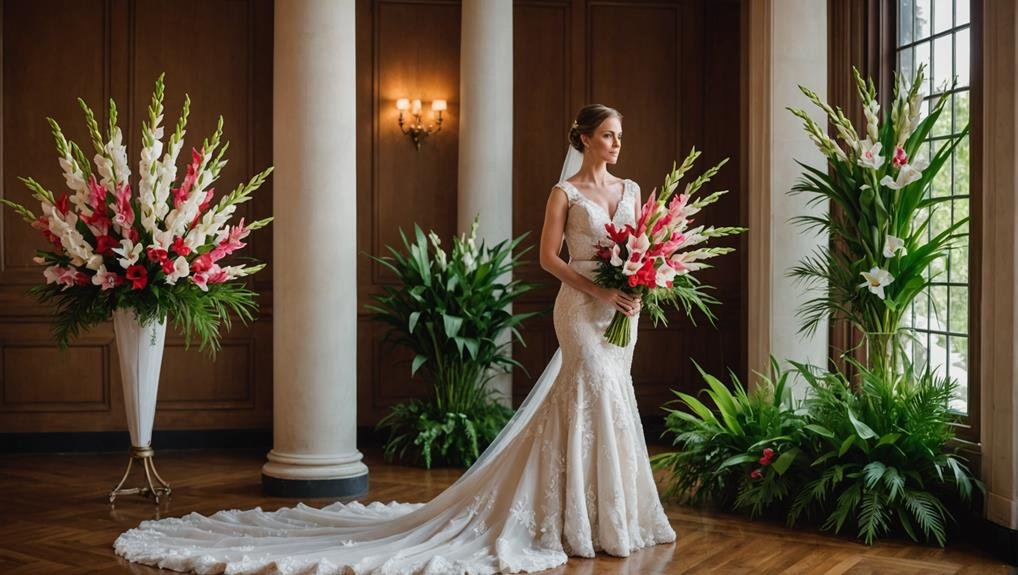
In wedding ceremonies, the gladiolus is often favored for its towering elegance and vibrant hues, contributing both visual impact and symbolic depth to the decor. These flowers are a popular choice for bridal bouquets due to their striking appearance and the meaningful qualities they symbolize, such as strength, sincerity, and admiration. Their tall stems and large blooms add a dramatic flair, making them ideal for creating memorable floral arrangements.
Gladioli’s versatility allows them to seamlessly fit into various wedding themes. For a minimalist aesthetic, they can be paired with simple greenery, creating an elegant and understated look. The long, linear shape of gladiolus stems complements clean lines and uncluttered spaces, enhancing the overall minimalist appeal.
On the other hand, when integrated with earthy tones, gladioli contribute to a rustic elegance, blending harmoniously with natural settings and wooden elements.
Additionally, the long vase life of gladioli makes them a practical choice for weddings, ensuring that the floral arrangements remain fresh and vibrant throughout the celebration. Whether used in centerpieces, bridal bouquets, or general decor, gladiolus flowers provide both beauty and longevity, making them a cherished addition to any wedding.
Alternative Flower Types
When considering alternative flower types for weddings, options such as dahlias, sunflowers, and peonies offer diverse aesthetic and symbolic values. These blooms can provide a personalized and unique touch to wedding florals, each carrying distinct meanings and visual appeal.
Dahlias:
Renowned for their versatility, dahlias come in various colors and shapes, making them a popular choice for wedding arrangements. Their intricate petals and vibrant hues can complement any wedding theme, from rustic to elegant.
Sunflowers:
Symbolizing happiness and cruciality, sunflowers add a cheerful and bright element to wedding decor. Their bold yellow color can create a striking contrast in bouquets and centerpieces, embodying joy and positivity.
Peonies:
Often associated with prosperity and good fortune, peonies are cherished for their lush, full blooms. Their romantic and soft appearance makes them ideal for bridal bouquets and luxurious floral arrangements.
Hydrangeas, Ranunculus, and Anemones:
For those seeking further alternatives, these flowers offer unique textures and colors. Incorporating these blooms can add depth and interest to wedding designs.
Pinterest accounts are excellent resources for inspiration, showcasing numerous gladiolus arrangements alongside these alternative flower types, allowing couples to visualize their perfect wedding florals.
